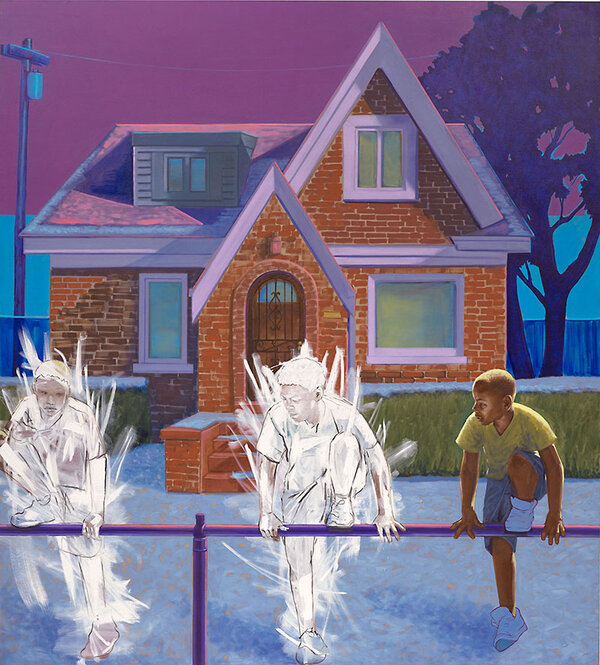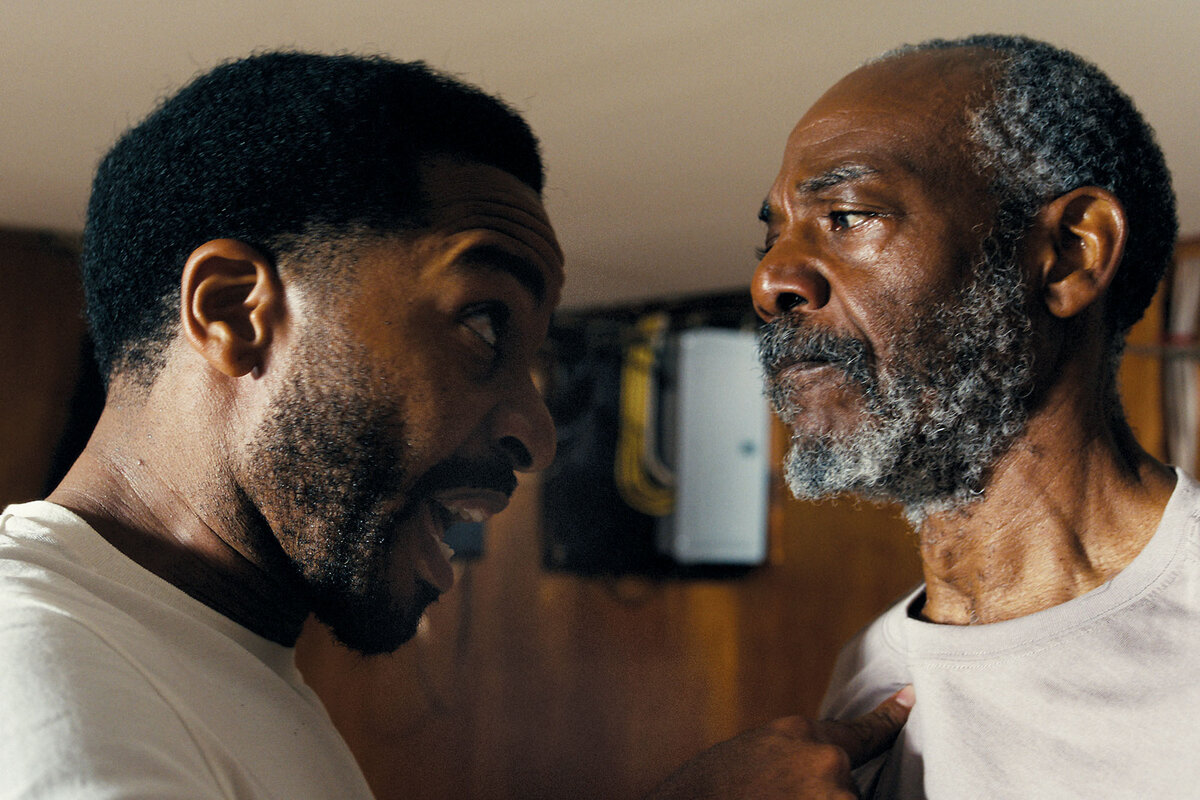This artist turned a forgiveness journey into a film – with the help of Steven Spielberg
Loading...
It took a phone call with Steven Spielberg to reassure Titus Kaphar that he was OK. While directing a scene in his debut movie, Mr. Kaphar had endured a breakdown.
“I literally said, ‘Cut’ and started sobbing,” he recalls. “I had to leave the set, locked myself in a dark room, and just lay there on the floor crying, letting these waves of heaving tears just roll over me.”
Mr. Kaphar’s drama “Exhibiting Forgiveness,” which opens in theaters Oct. 18, is inspired by his own life. He wrote the script. It’s the story of a famous painter who encounters his abusive father, a former drug addict, for the first time in 15 years. A reckoning is overdue.
Why We Wrote This
A story focused onAs his new movie debuts, artist Titus Kaphar reflects on what it takes to arrive at forgiveness – and to share it with the world.
André Holland’s performance as the artist unlocked something within Mr. Kaphar. As a child, he hadn’t been allowed to cry. This was new. He reached out to Mr. Spielberg, a new mentor.
“He told me, ‘I cried every day when I did my last film, “The Fabelmans.”’ It was really, really encouraging. And it gave me so much hope in the process,” says Mr. Kaphar during a video call from his Connecticut home.
Today, the filmmaker has many reasons to smile. The premiere for “Exhibiting Forgiveness” attracted attendees such as Serena Williams and Oprah Winfrey. Mr. Kaphar, a recipient of what’s often called the “genius grant” through the MacArthur Foundation, has had his paintings displayed at the Smithsonian’s National Portrait Gallery in Washington. He also launched an exhibition of artworks from the movie at the Gagosian gallery in Beverly Hills, California.
Reexamining grievances
But critical acclaim for “Exhibiting Forgiveness” isn’t as important to the director as his filmmaking journey. It transformed him. To tell the story, Mr. Kaphar had to reexamine his interpretation of grievances he’d been holding on to. The visually sumptuous movie examines what it takes to pardon wrongdoing.
“You can pause the film at any moment, and it would be something that you could frame on the wall,” says Alex Mallis, whose unconventional 2022 documentary about Mr. Kaphar, “Shut Up and Paint,” was also co-directed by its subject. “It’s not a surreal movie, but it has surreal emotion. ... You sort of tap into this feeling [of] empathy for who you see on-screen. And you can’t help but let a little bit of your own emotions seep in, and you see things you recognize big and small from your own life. It feels very specific and yet somehow also universal.”
Before now, the artist’s difficult childhood in a poor neighborhood of Kalamazoo, Michigan, hadn’t figured into the biography of his prodigious rise.
Famously, Mr. Kaphar was in his mid-20s when he decided to become an artist. The spark? An art history class in junior college. Mr. Kaphar taught himself how to paint by visiting art museums. In 2001, he completed an MFA degree at Yale. He was awarded the “genius grant” in 2018. His most famous work, “Behind the Myth of Benevolence,” is a commentary on Thomas Jefferson’s relationship with the enslaved woman Sally Hemings. In response to the death of George Floyd and other Black men killed by the police, Time magazine published Mr. Kaphar’s “Analogous Colors” on its cover. It depicts a mother holding a baby. The infant’s silhouette has been cut out of the canvas, leaving a blank space with the outline of its shape.
Yet for all the artist’s success, he was secretly having panic-attack nightmares about his father.
“I would wake up just flailing and hitting the wall,” says Mr. Kaphar. “It scared me the moment when I woke up and put a hole in the wall. I realized how bad it really was.”
Deliberate choices
Mr. Kaphar incorporated that detail into the movie. The protagonist, Tarrell Rodin, can’t shake images of his father’s drug use and violence toward his mother, Joyce (Aunjanue Ellis-Taylor). The movie itself, however, depicts those flashbacks with impressionistic techniques that create an impression of an assault without actually showing it.
“I was not going to participate in the kind of gratuitous, salacious violence that I’ve seen in film after film, particularly domestic violence against women,” says the director, who has sought filmmaking advice from supporters such as Mr. Spielberg and Spike Lee. “What we ultimately use is abstraction.”
In the movie, Tarrell has a surprise reunion with his father La’Ron (John Earl Jelks) when he takes his wife (Andra Day) and young son to visit his mother. Joyce implores her son to talk with La’Ron. Tarrell agrees to meet his father, but only if he can video the conversation. Many of those elements, too, are based on real-life events.
“I went to his house and I started filming him, which in fact is more or less the scene that you see in the movie,” says Mr. Kaphar. “I made [a] documentary based on those recordings and felt very dissatisfied with it because it did a very good job of telling us where we were, but not how we got there.”
Mr. Kaphar had long been promising his inquisitive children that, one day, he’d tell them the story of their grandfather. The artist began waking up each day at 5 a.m. to write for two hours. That narrative about his life became a script. Revisiting those childhood memories conjured up images that inspired him to paint canvases that became part of the movie.
“The thing that was the revelation is that my father is not the villain of my narrative,” says Mr. Kaphar, who’d left home to live with relatives in California after witnessing his father commit a “heinous” act. “In my own head, I had set him up to be that.”
While completing the script, Mr. Kaphar started writing and thinking from the perspective of La’Ron, the father. Mr. Kaphar realized that there are very few true villains in this world. Thinking back on his own childhood, in which he worked grueling and dangerous handyman jobs alongside his callous father, he recognized that his dad was trying to instill a work ethic to help him succeed in life. He’s grateful for it. More importantly, Mr. Kaphar now understands that his father loved him.
“A new compassion”
“I began to realize that my father is as much a victim as I was. My father suffered at the hands of his father and, in fact, did better than his father,” he says. “That was difficult for me to accept initially. But by the time I got finished, it was just clear. It was absolutely clear. It meant that I have developed a new compassion and sympathy for my father.”
Mr. Kaphar says that his father has begun a journey toward sobriety, but hasn’t yet reached the destination. When his mother saw “Exhibiting Forgiveness,” it deepened their relationship through new mutual understanding. Like his proxy character in the movie, Mr. Kaphar has let go of resentment toward his father. It had a healing effect.
“Since the film, I haven’t had any more of those nightmares,” says Mr. Kaphar. “I haven’t had one for almost two years now. So I feel very happy about that. My wife is very happy about that. My contractor is not so happy about that!”
Editor’s note: This article has been updated to correct Titus Kaphar’s quote, “The thing that was the revelation is that my father is not the villain of my narrative.”









